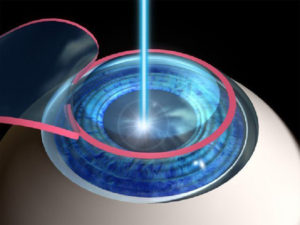 For over 25 years doctors placed incisions in the cornea to treat nearsightedness, farsightedness, and astigmatism. In the early 1980s, they began looking at lasers to improve the precision and predictability of altering the shape of the cornea. Researchers found that the Excimer laser could remove tissue with up to 0.25 microns of accuracy. Excimer laser has added a tremendous amount of precision, control and safety to the surgical correction of vision errors. The cornea is reshaped to conform to your glasses or contact lens prescription, thereby reducing dependence on corrective lenses for hundreds of thousands of Americans every year.
For over 25 years doctors placed incisions in the cornea to treat nearsightedness, farsightedness, and astigmatism. In the early 1980s, they began looking at lasers to improve the precision and predictability of altering the shape of the cornea. Researchers found that the Excimer laser could remove tissue with up to 0.25 microns of accuracy. Excimer laser has added a tremendous amount of precision, control and safety to the surgical correction of vision errors. The cornea is reshaped to conform to your glasses or contact lens prescription, thereby reducing dependence on corrective lenses for hundreds of thousands of Americans every year.
LASIK, or Laser in-Situ keratomileusis offers a number of benefits over other forms of laser vision correction because it is performed under a protective layer of corneal tissue. As a result, there is less surface area to heal, less risk of scarring, less risk of corneal haze, less postoperative discomfort, less postoperative need for medications, and vision returns more rapidly, often within a day or so. In LASIK, the surgeon cuts a thin flap of corneal tissue, folds it back, and then uses a laser to reshape the exposed corneal tissue. The flap is then restored to its original position. The procedure requires only anesthetic eye drops and takes less than 20 minutes. LASIK is generally a one-time procedure and has long-lasting effects.
In general, the ideal candidate for LASIK is over 18 years of age and has healthy corneas. Candidates must not have had a significant increase in their prescription in the last 12 months. People with certain medical conditions, such as cataracts, or women who are pregnant may not be good candidates for LASIK.
